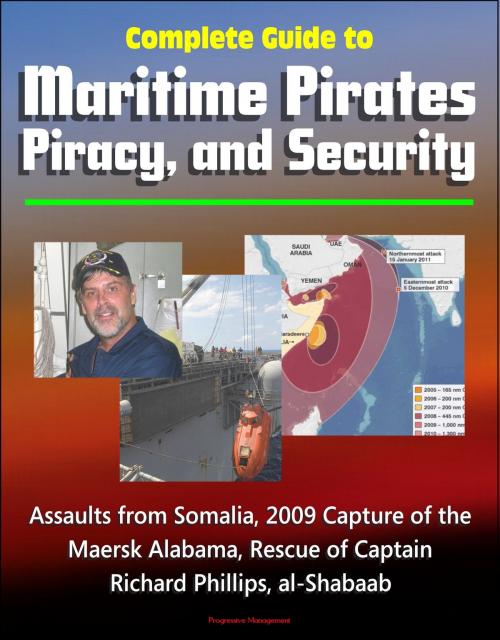Complete Guide to Maritime Pirates, Piracy, and Security, Assaults from Somalia, 2009 Capture of the Maersk Alabama, Rescue of Captain Richard Phillips, al-Shabaab
Nonfiction, History, Military, Naval, Social & Cultural Studies, Political Science| Author: | Progressive Management | ISBN: | 9781310833830 |
| Publisher: | Progressive Management | Publication: | October 25, 2013 |
| Imprint: | Smashwords Edition | Language: | English |
| Author: | Progressive Management |
| ISBN: | 9781310833830 |
| Publisher: | Progressive Management |
| Publication: | October 25, 2013 |
| Imprint: | Smashwords Edition |
| Language: | English |
This unique ebook provides an encyclopedic overview of all aspects of maritime piracy, assaults on shipping from Somali pirates, security measures including the work of the U.S. Navy, and the 2009 attack on the Maersk Alabama and the Navy rescue of Captain Richard Phillips. This massive compendium includes government reports, federal material, military information, and Congressional hearing transcripts.
Phillips was the master of MV Maersk Alabama when it was hijacked in April 2009 by Somali pirates. To ensure that his crew was released, he offered himself to the pirates as a hostage. "It's truly incredible to be chosen for this, I don't see myself as a hero... to be honored by this group is truly an honor," Phillips said. U.S. naval forces, including SEALS, rescued Phillips April 12. Following the rescue, Phillips was initially taken aboard the Norfolk, Va., based guided-missile destroyer USS Bainbridge (DDG 96).
Between 2005 and 2007, Somali pirates hijacked a number of vessels within 200 nautical miles of the Somali coast. By 2007 and 2008, pirate attacks off the coast of Somalia had begun to escalate dramatically. Motivated by escalating ransom payments that eventually grew to reach millions of dollars, more and more Somali men turned to piracy. As a result, piracy evolved from a fairly ad hoc, disorganized effort to a highly developed criminal enterprise. Somali pirates were able to improve their capabilities and expand their area of operations further and further from the Somali coast. At their peak, pirates could operate for weeks at a time up to 1,200 nautical miles from the Somali coast in shipping lanes off the Horn of Africa. At its maximum, the pirate operating area comprised an area more than 2.85 million square nautical miles, an area larger than the United States.
From 2008 to 2009, the number of successful pirate hijackings increased from 44 to 52, while the total number of piracy incidents (successful hijackings and unsuccessful attacks) more than doubled from 86 to 181. In 2010, the trend line remained relatively constant with 51 successful hijackings and 182 overall piracy incidents. By 2011 the trend reversed with the number of piracy incidents dropping to 166 and dropping further to only 32 in 2012. Likewise, the number of successful hijackings declined by 74 percent from 27 vessels in 2011 to only seven vessels in 2012 making 2012 the year with the lowest level of pirate activity since 2006. As of April 1 of this year, Somali pirates are holding only two vessels and sixty crewmembers hostage, a significant decline from the over 30 vessels and over 600 crewmembers held in early 2011.
The piracy material is supplemented by thorough coverage of the threat posed by terrorists from East Africa, focusing on the al-Shabaab group (also known as the Mujahideen Youth Movement MYM). These al-Qaeda affiliated terrorists claimed responsibility for the brutal assault on the Westgate Shopping Mall in Nairobi, Kenya on September 21, 2013.
al-Shabaab: Part 1: Overview * Part 2: Somalia: Line in the Sand — Identification Of MYM Vulnerabilities * Part 3: Senate Hearings, Violent Islamist Extremism: Al-Shabaab Recruitment in America * Part 4: House Hearings, The Extent of Radicalization in the American Muslim Community and that Community's Response * Part 5: Countering Terrorism in East Africa: The U.S. Response
This unique ebook provides an encyclopedic overview of all aspects of maritime piracy, assaults on shipping from Somali pirates, security measures including the work of the U.S. Navy, and the 2009 attack on the Maersk Alabama and the Navy rescue of Captain Richard Phillips. This massive compendium includes government reports, federal material, military information, and Congressional hearing transcripts.
Phillips was the master of MV Maersk Alabama when it was hijacked in April 2009 by Somali pirates. To ensure that his crew was released, he offered himself to the pirates as a hostage. "It's truly incredible to be chosen for this, I don't see myself as a hero... to be honored by this group is truly an honor," Phillips said. U.S. naval forces, including SEALS, rescued Phillips April 12. Following the rescue, Phillips was initially taken aboard the Norfolk, Va., based guided-missile destroyer USS Bainbridge (DDG 96).
Between 2005 and 2007, Somali pirates hijacked a number of vessels within 200 nautical miles of the Somali coast. By 2007 and 2008, pirate attacks off the coast of Somalia had begun to escalate dramatically. Motivated by escalating ransom payments that eventually grew to reach millions of dollars, more and more Somali men turned to piracy. As a result, piracy evolved from a fairly ad hoc, disorganized effort to a highly developed criminal enterprise. Somali pirates were able to improve their capabilities and expand their area of operations further and further from the Somali coast. At their peak, pirates could operate for weeks at a time up to 1,200 nautical miles from the Somali coast in shipping lanes off the Horn of Africa. At its maximum, the pirate operating area comprised an area more than 2.85 million square nautical miles, an area larger than the United States.
From 2008 to 2009, the number of successful pirate hijackings increased from 44 to 52, while the total number of piracy incidents (successful hijackings and unsuccessful attacks) more than doubled from 86 to 181. In 2010, the trend line remained relatively constant with 51 successful hijackings and 182 overall piracy incidents. By 2011 the trend reversed with the number of piracy incidents dropping to 166 and dropping further to only 32 in 2012. Likewise, the number of successful hijackings declined by 74 percent from 27 vessels in 2011 to only seven vessels in 2012 making 2012 the year with the lowest level of pirate activity since 2006. As of April 1 of this year, Somali pirates are holding only two vessels and sixty crewmembers hostage, a significant decline from the over 30 vessels and over 600 crewmembers held in early 2011.
The piracy material is supplemented by thorough coverage of the threat posed by terrorists from East Africa, focusing on the al-Shabaab group (also known as the Mujahideen Youth Movement MYM). These al-Qaeda affiliated terrorists claimed responsibility for the brutal assault on the Westgate Shopping Mall in Nairobi, Kenya on September 21, 2013.
al-Shabaab: Part 1: Overview * Part 2: Somalia: Line in the Sand — Identification Of MYM Vulnerabilities * Part 3: Senate Hearings, Violent Islamist Extremism: Al-Shabaab Recruitment in America * Part 4: House Hearings, The Extent of Radicalization in the American Muslim Community and that Community's Response * Part 5: Countering Terrorism in East Africa: The U.S. Response















